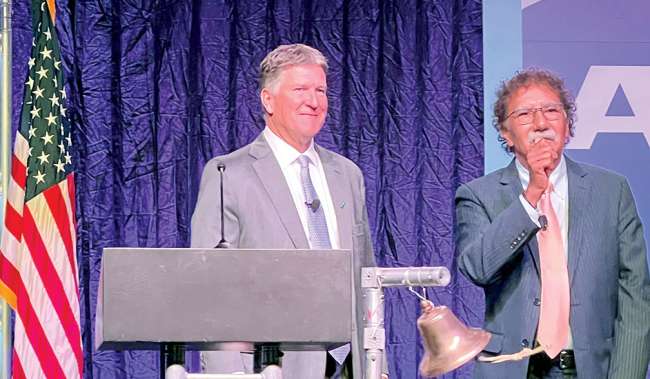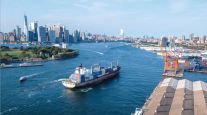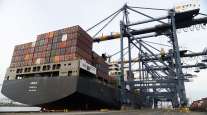Senior Reporter
Port Leaders to Stress Facilities’ Role in Supply Chain

[Stay on top of transportation news: Get TTNews in your inbox.]
With more than $19 billion in federal funding now available and an expected $6 billion more in state, local and private money coming, port leaders from around the nation will be in Washington on March 27-30 for the annual Legislative Summit hosted by American Association of Port Authorities.
It’s an opportunity for officials to hear from the Biden administration and meet with members of Congress. They will inform them of the importance of sea and land ports, especially how they kept the supply chain stabilized during the COVID-19 pandemic.
“We’re starting with a first-of-its-kind boot camp on [March 27], lead by a former congressman to teach our port leaders how to be an effective communicator and advocate and tell the story of their ports,” said Chris Connor, CEO of AAPA. “The message coming from the congressional district is just more powerful and there is more behind it.
"You get into the local communities, local government, mayors, county government, the state all rolling up to educate and hopefully influence the national leaders and Washington. I think that ground-up messaging that comes from our port leaders will complement the work we do at AAPA on the national level.”
Administration officials who will attend the summit, either in person or virtually, include Transportation Secretary Pete Buttigieg, Deputy Secretary of Transportation Polly Trottenberg, White House Supply Chain Envoy Retired Gen. Stephen Lyons and Senior Adviser Mitch Landrieu.
US DOT Deputy Secretary Polly Trottenberg will be joining us at AAPA’s Legislative Summit in Washington DC. AAPA is excited to host such an accomplished leader in the national transportation industry!
To register for the summit: https://t.co/uRQrJrYPFU pic.twitter.com/rsuJkNumuD — AAPA (@AAPA_Seaports) March 10, 2023
Connor said that with this large amount of money available to ports for dredging deeper channels, installing more cranes to handle larger ships and building more inland facilities, it’s important for government agencies that review projects and issue permits to find ways to speed up the process, without sacrificing environmental checks and balances.
“This is a big issue for the ports,” he said. “There is just a lot of frustration and concern about the time it takes in the application process, the time it takes that you are eligible for the money and you are an awardee and to the day you receive the money. There are a lot of permitting requirements and environmental requirements.”
Connor said he worries that if these projects take too long to get started, ports could lose spending power because of inflation, especially on high-dollar undertakings.
The longer it takes to get shovels into the ground, the more inflation creeps into the picture.
American Association of Port Authorities CEO Chris Connor
“No one in the port community is suggesting that we should act in a way that is not environmentally responsible. But many of us believe there are opportunities to take days out of the process, and turn those days into weeks and then that turns into months,” he said. “The longer it takes to get shovels into the ground, the more inflation creeps into the picture. And what was $50 million on day one is now $58 million on day 432.”
Connor also said port leaders will discuss the recent shift in cargo from the West Coast to the East Coast.
In the past six months, the ports of Los Angeles, Long Beach, Oakland and Seattle-Tacoma have seen their container volumes dip by more than 10%.
And in February, the Port of Los Angeles saw a 43% year-over-year drop in container cargo in February. The adjacent Port of Long Beach recorded a 32% year-over-year decline.
Volumes on the East Coast also were down in February, but not by nearly as much.
Port leaders on both coasts said the decline was caused in part by the Lunar New Year in February, which shuts down manufacturing in Asia.
As part of #Project11, we’ve made significant adjustments in our dredging contracts to ensure the work supports #soundmitigation measures. This includes #soundabsorption, #vibrationdamping application in engine rooms & more to minimize disruptions. Visit https://t.co/6xyztnACRp pic.twitter.com/SpLZnahjcT — Port Houston (@Port_Houston) March 7, 2023
But in the past five years, two ports in particular have seen their volumes surge — Port Houston, which is in the middle of a billion-dollar-plus upgrade, and the Port of Savannah, Ga., which is spending hundreds of millions to improve truck and rail connectivity.
Connor pointed out that the ports are responsible for more than $6 trillion (more than 25%) of the nation’s annual gross domestic product and that these facilities need the money that is coming if they are to remain competitive globally.
He said the role the ports played during the pandemic proves they are essential.
“I think it’s our job, now and forever, as the advocacy group for the port industry to never let it be forgotten how bad it got in 2020 and 2021, and to make sure we continue to get the federal-level support and spending we need to remain a modern and efficient freight movement chain, here in the U.S.”
Want more news? Listen to today's daily briefing below or go here for more info:




